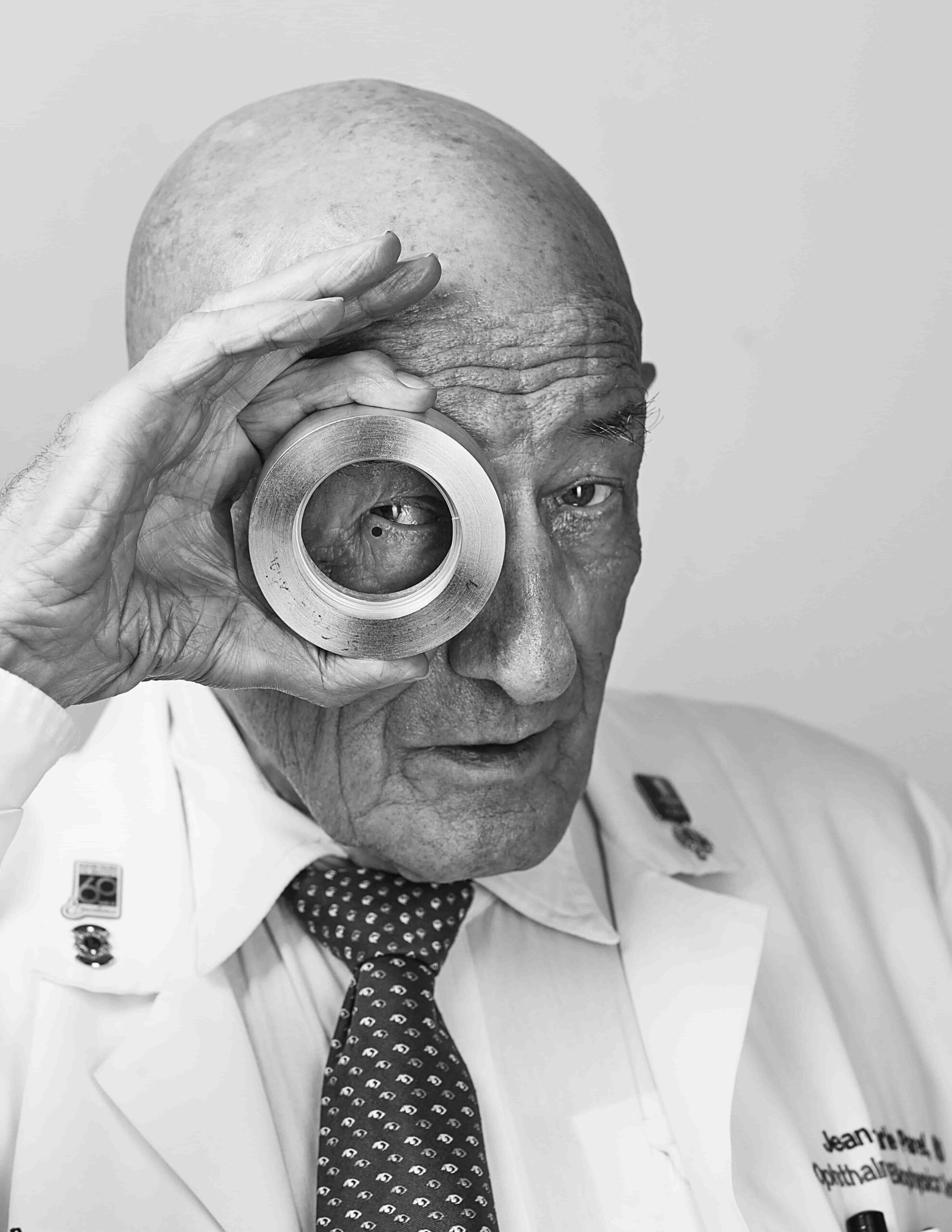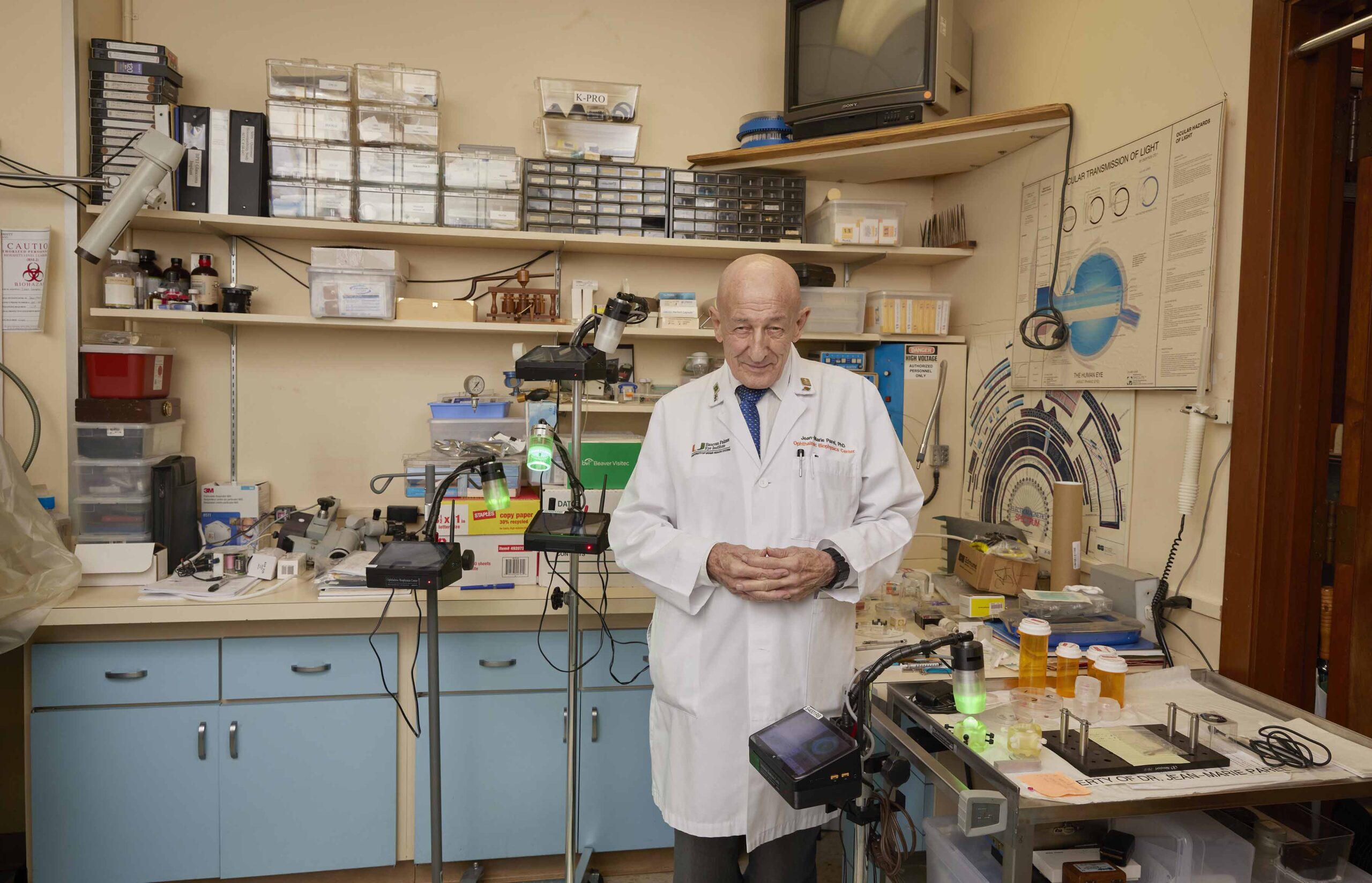Visionary Nonpareil
For more than a half century, Dr. Jean-Marie Parel, co-creator of Bascom Palmer’s Ophthalmic Biophysics Center, has overseen the development of hundreds of instruments and devices for patient care
By Bob Woods
Photography by Jeffery Salter

“
Let me tell you what happened in 1969,” said Jean-Marie Parel, Ing. ETS-G, Ph.D., director of the Ophthalmic Biophysics Center (OBC), part of the Miller School’s Bascom Palmer Eye Institute. He recalled being a newly hired biomedical engineer with Bascom Palmer and standing in an operating room, observing a delicate procedure to repair a patient’s eye.
“I noticed that the surgeons were having difficulty manually handling the surgical instruments,” the now 79-year-old Dr. Parel said. It turned out to be an aha moment that would soon inspire him and two fellow specialists to devise a mechanical instrument used in the procedure, known as vitrectomy, which is now the standard surgery for treating various problems with the retina and vitreous humor. “It is based on the machine that we invented,” he said, humbly concluding the episode.
A year later, Dr. Parel and Bascom Palmer’s founding chair, Edward W.D. Norton, M.D., created the OBC, which has since invented or improved more than 350 surgical instruments and clinical devices that have enhanced clinical optic care.
In addition to the vitrectomy device, the OBC and Bascom Palmer’s clinical faculty have co-invented tacks, a glaucoma micro-shunt the diameter of three eyelashes, and new devices for the treatment of cornea infections and surgery. Dr. Parel’s 159-page CV, in addition to citing hundreds of articles and book chapters he’s written and co-authored over the decades, lists dozens of inventions and novel ophthalmic procedures. They include the world’s smallest motorized scissors, used to cut retinal membranes that obscure vision; silicone oil used for the delivery of anti-inflammatory medication such as aspirin into the eye; an improved intra-ocular lens; an optical fiber laser device for ocular tissue welding; and a robotized slit lamp for remote eye exams.
Overseeing a Diverse Team
You might be tempted to liken Dr. Parel to the Ian Fleming’s fictitious character Q, who devised various gizmos for British Secret Intelligence Service Agent 007 — aka Bond, James Bond — from a fountain pen that doubled as a miniature pistol to an ejector seat in Bond’s signature Aston Martin that sent a menacing passenger airborne.
In reality, Dr. Parel, holder of the Henri and Flore Lesieur Chair in Ophthalmology, oversees a diverse team of scientists, engineers and technicians engaged in dozens of multidisciplinary projects encompassing telemedicine, robotics, lasers, gene therapy and other advanced technologies. Research areas at the OBC include glaucoma, cataracts, neuro-ophthalmology and ocular oncology. In the center’s experimental operating room, new instruments, implants and surgical techniques are clinically tested before they’re ready for real-world patient care.
“We used to only have a complete machine shop in the basement” where prototypes of optical gadgets designed in the OBC were produced, Dr. Parel said. Today, ideas come to life on computers running sophisticated mechanical design software. “So now, instead of going down to the machine shop, we can just download the design file to a 3D printer on campus that will make something in a matter of hours,” he said. “There are so many technologies that did not exist when I started that I’m learning new things every day.”
Dr. Parel’s backstory is a true tale of an inventor extraordinaire. Born in Switzerland in 1943, as World War II raged across Europe, he contracted polio as a young boy. “My mother, because I couldn’t go out and play with the other kids, taught me how to speak, how to read, how to add and subtract, and how to write French,” he recounted. The youngster grew particularly enamored with a medical dictionary, “because it had pictures in it that I would point to,” he said. “That’s what led me to want to go to medical school.”
“There are so many technologies that did not exist when I started that I’m learning new things every day.”
Where he ended up going, and studying, is another serendipitous story. After earning an undergraduate degree in physics and a master’s in applied math and electronic engineering, he interviewed with a member of the medical board at the University of Geneva, who asked what his father did for a living. “When I told the gentleman that my father was a watchmaker for Rolex, he wondered if he was an executive there,” Dr. Parel recalled. “When I said, ‘No, he just fixes watches,’ he replied, ‘I’m sorry, but you won’t be able to enter med school here because your father cannot afford it.”
Diverted though not dissuaded from pursuing a career in the medical world, Dr. Parel attended Bern University in Switzerland and received a master’s degree in physics and biophysics, disciplines that would guide his professional life — and improve the lives of countless patients. One of his professors at Bern was an ophthalmologist “who needed some help in ophthalmic optics,” Dr. Parel said, “and I fell in love with the field.” Thus, the son of a nurturing mother who raised a stricken but bookish son and a father who made a living as a skilled tinkerer grew up to become an eminent, patient-centric innovator.
“Patient First, Your Family Second, and You Last”
While Dr. Parel’s role at the OBC has been foundational in establishing its world-class reputation for innovation in developing new equipment to advance clinical care, he was quick to acknowledge the many collaborators whose contributions have been instrumental. First and foremost, he credited the late Dr. Norton, who instilled the center’s prime directive. “I asked Dr. Norton, ‘What are the rules at Bascom Palmer?’ He said, ‘Patient first, your family second, and you last.’”
Beyond Bascom Palmer, which is the Miller School’s Department of Ophthalmology, the OBC team interacts with experts in other departments. In fact, the co-director of the center is Fabrice Manns, Ph.D., professor and chairman of the Department of Biomedical Engineering, whose research involves the development of optical ophthalmic lasers and instruments. Dr. Parel is working with Roger Leblanc, Ph.D., chair and professor in the Department of Chemistry, to find a way to infuse medications into the eye without using an injection needle. The OBC is also working with the Diabetes Research Institute and other UM departments.
“We couldn’t do this work without their collaboration,” Dr. Parel said. “Whenever I need something, I can knock on their door or send them an email.” And, not surprisingly, medical device companies knock on Dr. Parel’s door. “They come to us with ideas for designing and testing optical instruments or techniques,” he said.
The Holy Grail: A Synthetic Cornea
Meanwhile, R&D related to innovative optical devices and instruments continues at the OBC. When asked to name a “holy grail” project, Parel mentions the center’s development of a synthetic cornea. More than 10 million people worldwide are bilaterally blind due to corneal diseases, but only about 100,000 corneal transplants are performed each year due to a lack of access to donor tissue. The OBC team is studying the biocompatibility of polymeric implants they’ve designed to mimic the natural cornea’s optical and biomechanical properties, as well as laser surgical procedures designed to improve the visual acuity of patients who receive the synthetic cornea.
“It makes me happy to see young clinicians with a big smile on their faces when they solve a patient’s problem.”
As Dr. Parel is approaching age 80, the “R” word comes up in conversation. “My wife thinks about it,” he admitted, “sometimes asking, ‘When are you going to retire?’ To be honest, I can’t imagine myself retiring. I’m happy with what I’m doing.”
Besides the continued satisfaction from his own work at the OBC, Parel also finds joy in teaching and mentoring the next generation of biomedical engineers and ophthalmologists. “It makes me happy to see young students and clinicians with a big smile on their faces when they solve a patient’s problem,” he said. “That is a wonderful gift.” ![]()



